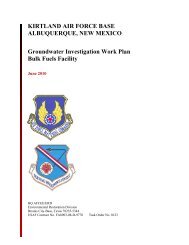Final FONSI and EA for hot cargo pad on Kirtland AFB - Kirtland Air ...
Final FONSI and EA for hot cargo pad on Kirtland AFB - Kirtland Air ...
Final FONSI and EA for hot cargo pad on Kirtland AFB - Kirtland Air ...
Create successful ePaper yourself
Turn your PDF publications into a flip-book with our unique Google optimized e-Paper software.
<str<strong>on</strong>g>Final</str<strong>on</strong>g> <str<strong>on</strong>g>EA</str<strong>on</strong>g> Addressing C<strong>on</strong>structi<strong>on</strong>, Operati<strong>on</strong>, <str<strong>on</strong>g>and</str<strong>on</strong>g> Maintenance of a Hot Cargo Pad<br />
nocturnal migrating species are attracted by lights <strong>on</strong> towers under these c<strong>on</strong>diti<strong>on</strong>s (USFWS undated).<br />
Although the lighting poles are not expected to exceed 200 feet in height, the possibility exists <str<strong>on</strong>g>for</str<strong>on</strong>g> the<br />
birds to be attracted to the lights in the Project area. Light attributes that reduce danger to migrating birds<br />
include dim lights, <str<strong>on</strong>g>and</str<strong>on</strong>g> lights with l<strong>on</strong>g flash time intervals <str<strong>on</strong>g>and</str<strong>on</strong>g> short flash durati<strong>on</strong>. These have been<br />
dem<strong>on</strong>strated to reduce the danger to migrating birds. Impacts are expected to be minimal due to the low<br />
pole height <str<strong>on</strong>g>and</str<strong>on</strong>g> design (i.e., single mast poles without support cables). Overall, due to the current status<br />
of the site <str<strong>on</strong>g>and</str<strong>on</strong>g> its locati<strong>on</strong> in a developed area, impacts <strong>on</strong> the wildlife species <str<strong>on</strong>g>and</str<strong>on</strong>g> habitat would be less<br />
than significant.<br />
Threatened <str<strong>on</strong>g>and</str<strong>on</strong>g> Endangered Species<br />
The burrowing owl (Athene cunicularia) is the <strong>on</strong>ly species of c<strong>on</strong>cern listed by the USFWS in the<br />
vicinity. There are three burrowing owl nesting locati<strong>on</strong>s within 400 feet of the QD clear z<strong>on</strong>e associated<br />
with the proposed <str<strong>on</strong>g>hot</str<strong>on</strong>g> <str<strong>on</strong>g>cargo</str<strong>on</strong>g> <str<strong>on</strong>g>pad</str<strong>on</strong>g> <str<strong>on</strong>g>and</str<strong>on</strong>g> <strong>on</strong>e owl locati<strong>on</strong> within 50 feet of the proposed <str<strong>on</strong>g>hot</str<strong>on</strong>g> <str<strong>on</strong>g>cargo</str<strong>on</strong>g> <str<strong>on</strong>g>pad</str<strong>on</strong>g><br />
taxiway (Figure 3-8). During ground disturbing c<strong>on</strong>structi<strong>on</strong> <str<strong>on</strong>g>and</str<strong>on</strong>g> demoliti<strong>on</strong> activities, there is the<br />
possibility that at least <strong>on</strong>e of these nests could be disturbed. The category of species of c<strong>on</strong>cern, which<br />
applies to the burrowing owl, carries no legal requirement, but identifies those species that deserve special<br />
c<strong>on</strong>siderati<strong>on</strong> in management <str<strong>on</strong>g>and</str<strong>on</strong>g> planning. Kirtl<str<strong>on</strong>g>and</str<strong>on</strong>g> <strong>AFB</strong> already has a program in place that identifies<br />
locati<strong>on</strong>s of nesting burrowing owls <str<strong>on</strong>g>and</str<strong>on</strong>g> has developed procedures to relocate owls if necessary. To<br />
avoid disturbances to potential nesting burrowing owls, a survey would be c<strong>on</strong>ducted prior to any ground<br />
disturbing demoliti<strong>on</strong> <str<strong>on</strong>g>and</str<strong>on</strong>g> c<strong>on</strong>structi<strong>on</strong> activities. If owls are present, ground disturbing demoliti<strong>on</strong> <str<strong>on</strong>g>and</str<strong>on</strong>g><br />
c<strong>on</strong>structi<strong>on</strong> activities would <strong>on</strong>ly commence after the owls have left from the area (i.e., October 15<br />
through March 15). Additi<strong>on</strong>ally, nesting burrows would be flagged <str<strong>on</strong>g>and</str<strong>on</strong>g> avoided during ground<br />
disturbing demoliti<strong>on</strong> <str<strong>on</strong>g>and</str<strong>on</strong>g> c<strong>on</strong>structi<strong>on</strong> activities, so that the nesting sites could still be viable after<br />
activities. There<str<strong>on</strong>g>for</str<strong>on</strong>g>e, any impacts <strong>on</strong> burrowing owls would be expected to be less than significant.<br />
Wetl<str<strong>on</strong>g>and</str<strong>on</strong>g>s<br />
The USACE <str<strong>on</strong>g>and</str<strong>on</strong>g> USEPA regulate <str<strong>on</strong>g>and</str<strong>on</strong>g> permit dredge <str<strong>on</strong>g>and</str<strong>on</strong>g> fill activities within the waters of the United<br />
States, including wetl<str<strong>on</strong>g>and</str<strong>on</strong>g>s under the authority of Secti<strong>on</strong> 404 of the CWA. The USEPA reviews <str<strong>on</strong>g>and</str<strong>on</strong>g><br />
provides input to the permit applicati<strong>on</strong>s.<br />
No wetl<str<strong>on</strong>g>and</str<strong>on</strong>g>s are located <strong>on</strong> the proposed <str<strong>on</strong>g>hot</str<strong>on</strong>g> <str<strong>on</strong>g>cargo</str<strong>on</strong>g> <str<strong>on</strong>g>pad</str<strong>on</strong>g> site; there<str<strong>on</strong>g>for</str<strong>on</strong>g>e, no impacts <strong>on</strong> wetl<str<strong>on</strong>g>and</str<strong>on</strong>g>s would be<br />
expected.<br />
4.7.2.2 No Acti<strong>on</strong> Alternative<br />
Under the No Acti<strong>on</strong> Alternative, the 377 ABW would not c<strong>on</strong>struct the proposed <str<strong>on</strong>g>hot</str<strong>on</strong>g> <str<strong>on</strong>g>cargo</str<strong>on</strong>g> <str<strong>on</strong>g>pad</str<strong>on</strong>g> <str<strong>on</strong>g>and</str<strong>on</strong>g> new<br />
taxiway. Selecti<strong>on</strong> of this alternative would result in c<strong>on</strong>tinued deteriorati<strong>on</strong> of the existing <str<strong>on</strong>g>cargo</str<strong>on</strong>g> <str<strong>on</strong>g>pad</str<strong>on</strong>g><br />
that does not meet current envir<strong>on</strong>mental st<str<strong>on</strong>g>and</str<strong>on</strong>g>ards. Furthermore, the frequent maintenance <str<strong>on</strong>g>and</str<strong>on</strong>g> repair to<br />
the existing <str<strong>on</strong>g>cargo</str<strong>on</strong>g> <str<strong>on</strong>g>pad</str<strong>on</strong>g> would result in increased noise <str<strong>on</strong>g>and</str<strong>on</strong>g> disturbance by maintenance pers<strong>on</strong>nel <str<strong>on</strong>g>and</str<strong>on</strong>g><br />
vehicles.<br />
4.8 Cultural Resources<br />
4.8.1 Evaluati<strong>on</strong> Criteria<br />
Adverse impacts <strong>on</strong> cultural resources can include physically altering, damaging, or destroying all or part<br />
of a resource; altering characteristics of the surrounding envir<strong>on</strong>ment that c<strong>on</strong>tribute to the resource’s<br />
significance; introducing visual or audible elements that are out of character with the property or that alter<br />
its setting; general neglect of the resource to the extent that it deteriorates or is destroyed; or the sale,<br />
Kirtl<str<strong>on</strong>g>and</str<strong>on</strong>g> <strong>AFB</strong>, NM January 2011<br />
4-13
















